
Service Category
Mobile App Development
Mobile app development is the process of designing, creating, and deploying software applications specifically for mobile devices such as smartphones and tablets. These apps are built to run on various operating systems like Android, iOS, or both. Mobile apps have become an essential part of modern life, catering to a wide range of needs including communication, entertainment, productivity, and e-commerce.
Mobile app development involves user interface design, backend development, integration of APIs, testing, and deployment. With the rapid growth of mobile users, businesses invest in app development to enhance customer engagement and streamline operations.









.png)